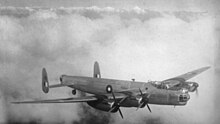Avro Lincoln
[5][4] The prototype Lancaster IV, later renamed the Lincoln I, was assembled by Avro's experimental flight department at Manchester's Ringway Airport.
[6] According to aviation author Kev Delve, development of the Lincoln had proceeded relatively smoothly.
[6] The type was mainly produced at Avro's Woodford, Cheshire and Chadderton Lancashire factories; additional aircraft were also constructed by Armstrong Whitworth at their Coventry facilities.
Production in Australia went ahead: the Lincolns that were manufactured there were operated by the Royal Australian Air Force (RAAF).
During early 1945, the British Government immediately set about restoring the country to a peacetime stance, which involved the demobilisation of the military and, more specifically, the disbanding of many squadrons of the Royal Air Force (RAF) as a part of cost-saving measures.
[2] A new emphasis was soon placed on 'quality over quantity' during the rationalisation process, seeking to employ fewer but more capable aircraft to perform their envisioned roles; while there was no longer any urgency in bringing new types of aircraft into service, limited procurement of equipment that fell within this ethos did proceed.
[2] In accordance with this aim, the British Air Ministry proceeded to formulate and release Specification B.14/43, which sought an improved piston-engined heavy bomber to replace the wartime four-engine bombers, the Short Stirling, the Handley Page Halifax, and the Avro Lancaster.
During the 1950s, the RAAF heavily modified some of their Mk 30 aircraft to perform anti-submarine warfare (ASW) missions, re-designating them Lincoln GR.Mk 31.
These examples had a 6 ft 6 in (1.98 m) longer nose to house acoustic submarine detection gear and its operators, larger fuel tanks to provide the aircraft with a 13-hour flight endurance, and a modified bomb bay to accommodate torpedoes.
A dedicated maritime patrol aircraft, designated the Avro Shackleton, was developed for the RAF and the South African Air Force (SAAF).
Nearly 600 Lincolns were constructed to equip a total of 29 RAF squadrons, the majority of which were based in the United Kingdom.
They were supplemented and partially replaced by 88 Boeing Washingtons, on loan from the USAF, which had longer range and could reach targets inside the Iron Curtain.
[16] Small numbers remained in use with Nos 7, 83 and 97 Squadrons until the end of 1955, at which point the type was phased out, having been replaced by the first of the V bombers.
[15] On 12 March 1953, an RAF Lincoln (RF531 "C") of Central Gunnery School was shot down 20 mi (32 km) NE of Lüneburg, Germany by several Soviet MiG-15s as it flew to Berlin on a radar reconnaissance flight,[17] killing the seven crew members.
As the RAF Lincolns became unserviceable, primarily due to progressive wear and tear, they were replaced by a variety of jet-powered aircraft.
[26] In 1948, one of the bombers was returned to Avro for modification at RAF Langar in Nottinghamshire to allow it to operate these Antarctic support flights; the changes included the addition of Lancastrian nose and tail cones, additional fuel tanks, and removal of armament; this led to the aircraft becoming the first Avro Lincolnian.
[21][27] Modified as such, the aircraft received a civilian registration and was named Cruz del Sur; it undertook its first aerial supply flight to the Antarctic San Martín Base in December 1951.
RF403, RE339/G and SX972 flew with a pair of Armstrong Siddeley Python turboprops outboard in place of the Merlins, and was used for the ballistic casing drop-test programme for the Blue Danube atomic weapon.
It later flew, bearing the civilian "Class B" test registration G-37-1, with a similarly placed Rolls-Royce Tyne which it displayed at the 1956 Society of British Aircraft Constructors (SBAC) show, making a low level flypast on just the nose Tyne, the four Merlins being shut down and propellers feathered.
[31] RA643 flew with a Bristol Phoebus turbojet in the bomb bay, and SX971 had an afterburning Rolls-Royce Derwent mounted ventrally.
A transport conversion of the Lincoln II, using the streamlined nose and tail cones of the Lancastrian and a ventral cargo pannier, was known as the Avro 695 Lincolnian.











